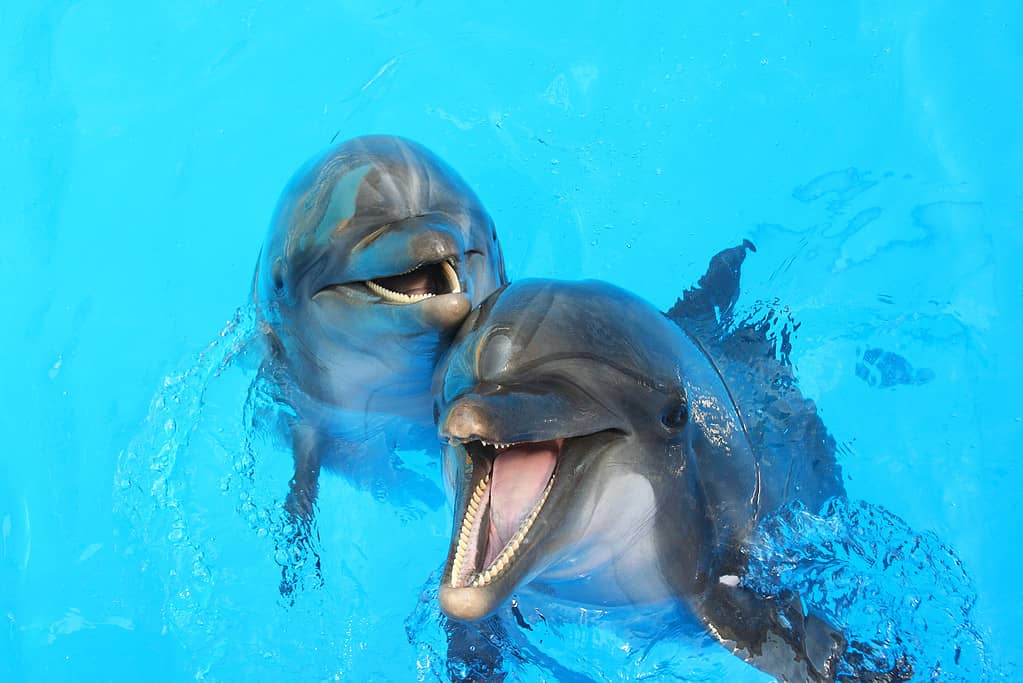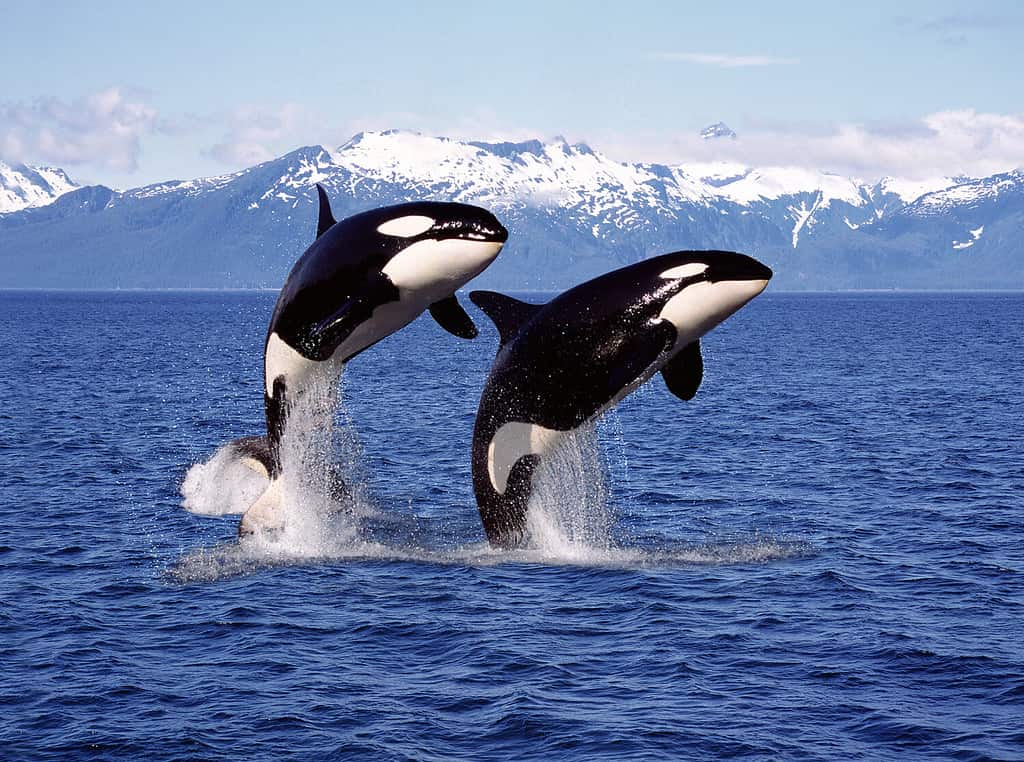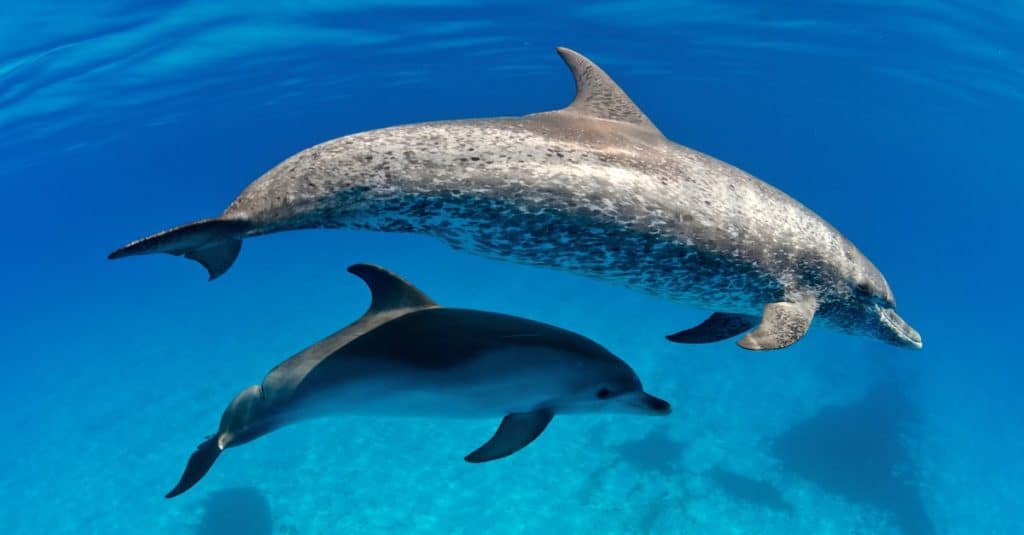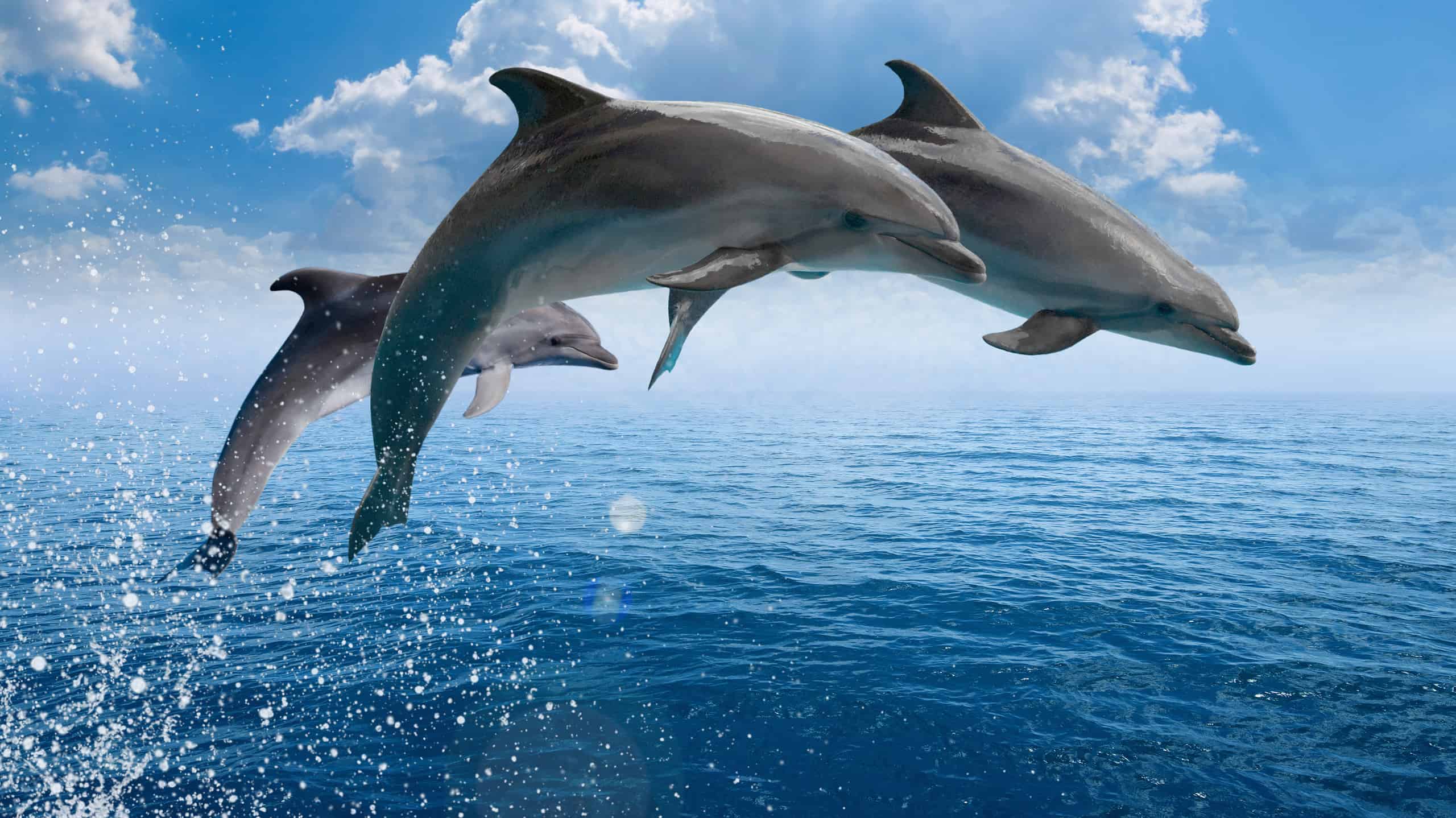Depending on the species, it is challenging to differentiate between male vs. female dolphins as they usually look very similar. You would need to know what to look for, and even then, it isn’t easy. However, there are some features that divulge the sex of a dolphin. So, here are four key differences between male vs. female dolphins.
The 4 Key Differences Between Male vs. Female Dolphins
When it comes to differentiating between male and female dolphins, it’s not just their appearance that gives them away. There are four key differences, physical and behavioral, that help tell them apart.
1. Male vs. Female Dolphin: Physical Differences

If you can get close enough, you will notice that males are nearly twice the size of females, making them noticeably rounder.
©Cory Fults/Shutterstock.com
While male and female dolphins look very similar, the males are usually larger. However, they are similar in length to the females, so you will need to get a really good look to determine which is which. If you can get close enough, you will notice that males are nearly twice the size of females, making them noticeably rounder. Females are smaller because they reach sexual maturity before males do, giving them less time to grow.
Weight and Length
Female bottlenose dolphins usually measure between 89 to 144 inches long, while males grow 96 to 150 inches long. However, males can weigh up to 1,100 pounds, but females can weigh up to 550 pounds.
Reproductive Anatomy
While you may be able to determine the sex of a dolphin by their size. The only foolproof way to tell the difference between male vs. female dolphins is by getting a glimpse of their bellies, which can be tricky. However, if you are dealing with a highly acrobatic and playful species, like the Pacific white-sided dolphin, it may be easier than you think, as they love to jump out of the water doing somersaults and other displays of excitement. But what is so special about their bellies?
Males
You can tell if a dolphin is male because they have an umbilical scar or belly button and two slits down their bellies, the genital and anal slit. These slits are clearly separate; many researchers say they look like exclamation points.
Females
The females are a bit different. They also have an umbilical scar or belly button. However, females have three slits, the genital slit and two mammary slits. But, unlike the males, the female’s genital slits are not separate; their vagina and anus are both contained in one long genital slit. Furthermore, the two mammary slits lie on either side of the genital slit. As a result, many people think the slits on female dolphins look like the divide sign.
2. Male vs. Female Dolphin: Social Differences

Bottlenose dolphin
males in Australia form groups for social purposes and to attract females with two different strategies.
©slowmotiongli/Shutterstock.com
The male bottlenose dolphin differs from the female bottlenose dolphin when it comes to social habits. For example, females primarily form alliances for food resources and only seem to associate with males for reproduction. However, males in Australia form groups for social purposes and to attract females with two different strategies.
The first strategy consists of forming a small and stable alliance, with no more than three males working together to control individual females ready to reproduce. Furthermore, teams of two usually cooperate to attack other groups of males or defend against them. The second strategy consists of the formation of interchangeable alliances within a larger second-order alliance referred to as a superalliance. This is when males often switch partners within the superalliance.
3. Male vs. Female Dolphin: Reproductive Differences

Females reach sexual maturity once they have gained 85 to 95 percent of their adult body length; this usually occurs between 7 to 12 years of age. However, males usually only reach this size between 10 to 15 years old.
©Christopher Berthelot/Shutterstock.com
The age of sexual maturity significantly varies between male and female bottlenose dolphins depending on their location and population. However, when they sexually mature is based on their size, not age. For example, females reach sexual maturity once they have gained 85 to 95 percent of their adult body length; this usually occurs between 7 to 12 years of age. However, males usually only reach this size between 10 to 15 years old. The huge difference in the age of sexual maturity in dolphins is called bimaturism.
4. Male vs. Female Dolphin: Caring for Offspring

Research shows that male dolphin’s investment in their offspring is virtually nonexistent, especially among bottlenose dolphins. But, females take great care of their offspring and are the primary influence in their lives.
©Elena Larina/Shutterstock.com
Research shows that male dolphin’s investment in their offspring is virtually nonexistent, especially among bottlenose dolphins. But, females take great care of their offspring and are the primary influence in their lives. However, some females form maternal pods with related and unrelated females to help share the duties. It really does take a village, much like human children.
Some males show a bit of interest in their calves. For example, they sometimes swim close to their offspring during mother-calf interactions. Furthermore, variations of male care have been documented across several mammal species, including bottlenose dolphins. Some male species will engage in caring for their young to develop stronger bonds with eligible mates, increase genetic fitness, improve offspring survival, increase reproductive output, and decrease inter-birth intervals.
Types of Dolphins
There are 42 species of dolphins on the planet, but not all of them share the same features and characteristics. Here are some of the dolphin species you can find in the ocean.
Dusky Dolphin

The dusky dolphin is often seen jumping and diving in and out of the water, so they are called the acrobats of the sea.
©Allen McC / Creative Commons – Original
The dusky dolphin is often seen jumping and diving in and out of the water, so they are called the acrobats of the sea. They occur in coastal waters throughout the Southern Hemisphere, with massive populations around New Zealand, South Africa, and South America. These dolphins are quite small, often growing to around 6 feet long and weighing about 200 pounds.
Orca

Orcas are special when it comes to their social bonds, which are extremely complex, only comparable to higher primates and
elephants
.
©slowmotiongli/Shutterstock.com
The largest species of dolphin is the Orca or Killer Whale. They inhabit every ocean on the planet, surviving in all temperatures, from tropical waters to Antarctica. Males typically measure between 20 to 26 feet long and weigh around three to four tons. Orcas are special when it comes to their social bonds, which are extremely complex, only comparable to higher primates and elephants.
Atlantic Spotted Dolphin

The Atlantic spotted dolphin occurs in tropical waters in certain parts of the Atlantic Ocean, primarily in the Bahamas.
©Joost van Uffelen/Shutterstock.com
The Atlantic spotted dolphin occurs in tropical waters in certain parts of the Atlantic Ocean, primarily in the Bahamas. While juveniles are generally monochrome gray, adults have small black spots all over their bodies. These dolphins are medium in size, measuring 7.5 feet and weighing around 300 pounds.
Peale’s Dolphin

This small species is found in areas in the southern cone of South America. Peale’s dolphins usually grow to around 7 feet long and weigh approximately 200 pounds when they are adults.
©Chase Dekker/Shutterstock.com
This small species is found in areas in the southern cone of South America. Peale’s dolphins usually grow to around 7 feet long and weigh approximately 200 pounds when they are adults. These dolphins are a mix of black and dark gray, fading into white on their bellies. Furthermore, they have bow-shaped dorsal fins.
Thank you for reading! Have some feedback for us? Contact the AZ Animals editorial team.








